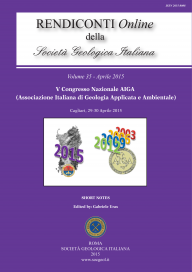
High-resolution geological model of the gravitational deformation affecting the western slope of Mt. Epomeo (Ischia)
Marta Della Seta (a), Carlo Esposito (a), Gian Marco Marmoni (a), Salvatore Martino (a), Antonella Paciello (b), Cristina Perinelli (a) & Gianluca Sottili (c)
(a) Sapienza Università di Roma – Dipartimento di Scienze della Terra e Centro di Ricerca CERI, Piazzale Aldo Moro, 5, 00185, Roma, Italia. E-mail: gianmarco.marmoni@uniroma1.it
(b) Agenzia Nazionale per le nuove tecnologie, l'energia e lo sviluppo economico sostenibile (ENEA-Casaccia) - Via Anguillarese, 301, 00123 Roma, Italia.
(c) CNR, Istituto di Geologia Ambientale e Geoingegneria (IGAG), Monterotondo, Roma, Italia.
DOI: https://doi.org/10.3301/ROL.2015.75
Volume: 35/2015
Pages: 104-108
Abstract
The recent geological history of Ischia Island is characterized by slope-scale gravitational deformations closely related to volcano-tectonic dynamics of the Mt. Epomeo resurgent caldera. This study focuses on the gravitational deformation that involves alkali-trachytic lava and trachytic ignimbrite flow-units of Mt. Nuovo, located in the western portion of Mt. Epomeo. A preliminary, high-resolution engineering-geological model was obtained through geological, geomorphological and geophysical surveys and reveals a complex morpho-structure with geomorphological evidence of gravitational instability. The complexity of the ongoing slope deformations is confirmed by field geo-structural evidences that led to the identification of a multiple compound mechanism with a main rupture surface which is about 200 m deep. This geometry was better constrained by passive seismic investigations consisting in noise measurements, focused on resonance frequencies of the soil (i.e. based on H/V Nakamura approach). In addition, a close relationship between the outcrop of Mt. Epomeo Green Tuff breccia layers and the distribution of hydrothermal emissions and gas vent can be inferred, as it is related to the higher permeability of the breccia layers with respect to the main Mt. Epomeo Green Tuff flow unit, where the ascent path of deep hydrothermal fluids developed along faults and fracture networks.
Keywords
Ischia, geological model, deep-seated gravitational slope deformation, slope instability, volcanic hazards.
Get Full Text